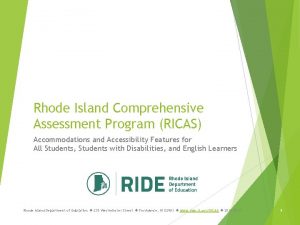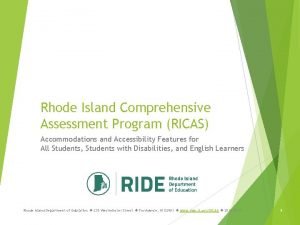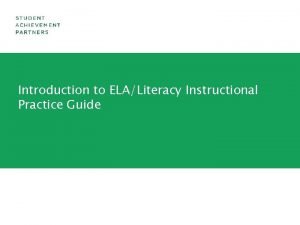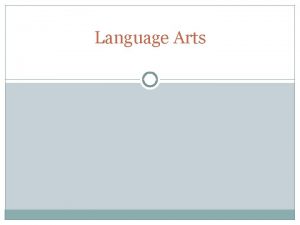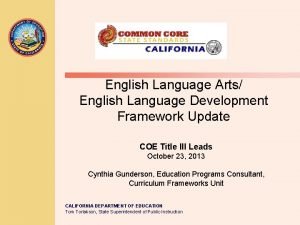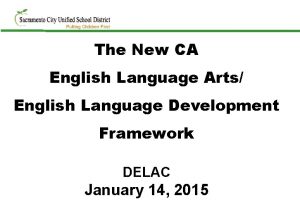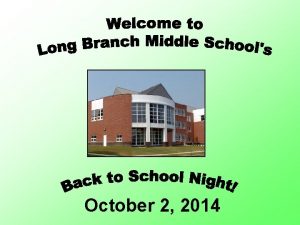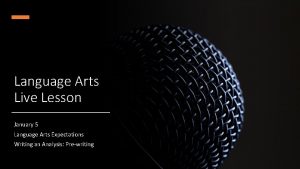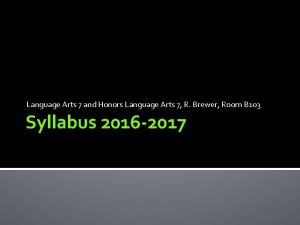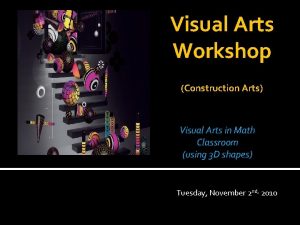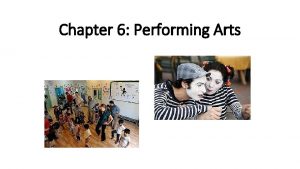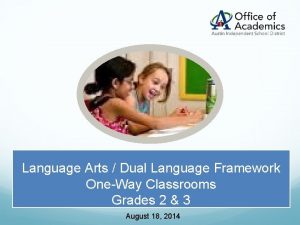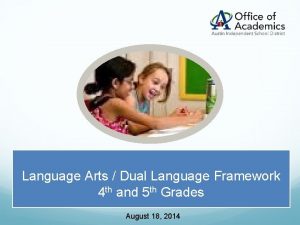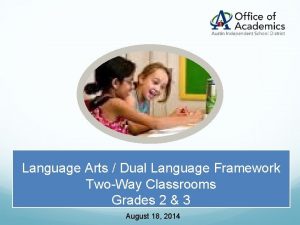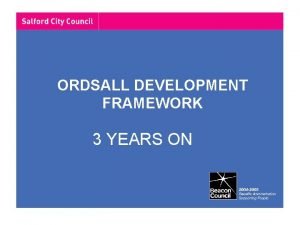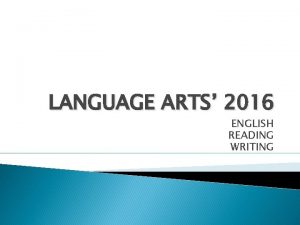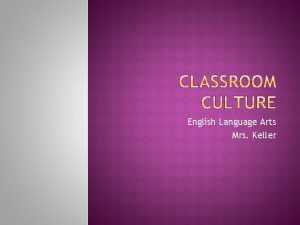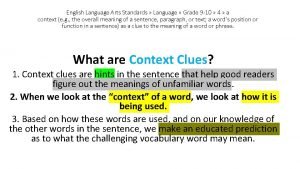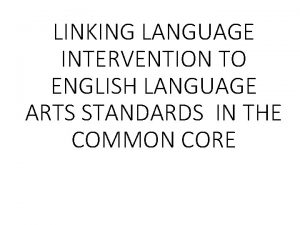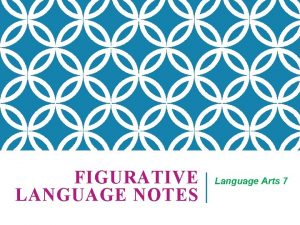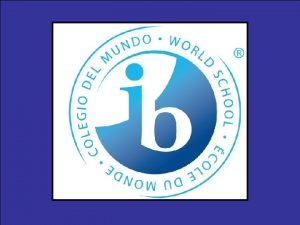English Language Arts English Language Development Framework for
























- Slides: 24

English Language Arts/ English Language Development Framework for California Public Schools: Transitional Kindergarten Through Grade Twelve (ELA/ELD Framework)

Big Ideas of the 2014 ELA/ELD Framework ● ● ● ● College, Career, and Civics Designated and Integrated ELD Formative assessment Access and Equity MTSS 21 st Century learning Professional learning http: //www. lionsmd 19. com/wa tsnew/what's%20 new. htm

Chapters 1 -7: Key Considerations in ELA/Literacy and ELD Instruction

Designated ELD “Designated ELD is a protected time during the regular school day where teachers use the CA ELD Standards as the focal standards in ways that build into and from content instruction in order to develop critical English language skills, knowledge, and abilities needed for content learning in English. ” ELA/ELD framework, Chapter 2 Integrated ELD “The ELA/ELD framework uses the term integrated ELD to refer to ELD throughout the day and across the disciplines. All teachers with ELs in their classrooms should use the CA ELD Standards in addition to their focal CA CCSS for ELA/Literacy and other content standards to support their ELs’ linguistic and academic progress. ” ELA/ELD framework, Chapter 2 Introduction to California English Language Development Standards: http: //youtu. be/y. Ckgvgepv 1 w

Chapter 1 - 7 Overview ● Chapters 3– 7: Content and Pedagogy: Chapter 3: TK–Grade 1 Chapter 4: Grades 2– 3 Chapter 5: Grades 4– 5 Chapter 6: Grades 6– 8 Chapter 7: Grades 9– 12 ● Common Topics and Features Motivation and Engagement Framing Questions for Instructional Planning Collaboration Snapshots & Vignettes across Disciplines

Chapter 8: Assessment ● Short-Cycle Formative Assessment ● Medium-Cycle Assessment o End-of-Unit Assessments o Interim or Benchmark Assessments ● Long-Cycle Assessment o Annual/End-of-Year Assessments ● Rubrics ● Portfolios (ELA/ELD Framework, p. 1)

Formative Assessment Defined “Formative assessment occurs in real time, during instruction while student learning is underway. ” (Allal 2010; 90 Black and Wiliam 1998; Bell and Cowie 2000; Heritage 2010; Shepard 2000 2005).

The Essential Elements of Formative Assessment ● Clearning goals and success criteria. ● Eliciting gathering and interpretation. ● Responsive pedagogical action. ● Student involvement. (Margaret Heritage, Presentation Irvine California, February 25, 2014)

What does formative assessment look like in a classroom?

The Formative Assessment Cycle Examine Student Work Inform Teacher Knowledge Administer Tasks Formative Assessment Cycle Anticipate Student Understand ing Inform Instruction al Moves Select an Instruction al Task http: //www. wested. org/wp-content/files_mf/1391626953 Formative. Assessment_report 5. pdf (Focusing Formative Assessment on the Needs of English Language Learners, pp. 1 -36)

Formative Assessment has two fundamental purposes: one is to provide information about student learning minute-by-minute, day-to-day, and week-to-week so teachers can continuously adapt instruction to meet students’ specific needs and secure progress. This type of assessment is intended to assist learning and is often referred to as formative assessment or assessment for learning. Formative assessment occurs in real time, during instruction while student learning is underway (Allal 2010; Black and Wiliam 1998; Bell and Cowie 2000; Heritage 2010; Shepard 2000, 2005). For example, a third grade teacher working with small groups of students on distinguishing their point of view from a particular author’s is able to gain insights into students’ developing skills through the use of strategic questions and can adjust instruction and students’ next steps immediately based on the students’ responses. http: //www. cde. ca. gov/ci/rl/cf/documents/chapter 8 sbeadopted. pdf (ELA/ELD Framework, p. 5)

Formative Assessment Figure 8. 2. What is Formative Assessment? What is formative assessment? Formative assessment is a process teachers and students use during instruction that provides feedback to adjust ongoing teaching moves and learning tactics. It is not a tool or an event, nor a bank of test items or performance tasks. Well‐supported by research evidence, it improves students’ learning in time to achieve intended instructional outcomes. Key features include: 1. Clear lesson‐learning goals and success criteria, so students understand what they’re aiming for; 2. Evidence of learning gathered during lessons to determine where students are relative to goals; 3. A pedagogical response to evidence, including descriptive feedback that supports learning by helping students answer: Where am I going? Where am I now? What are my next steps? 4. Peer‐ and self‐assessment to strengthen students’ learning, efficacy, confidence, and autonomy; 5. A collaborative classroom culture where students and teachers are partners in learning. http: //www. cde. ca. gov/ci/rl/cf/documents/chapter 8 sbeadopted. pdf (ELA/ELD Framework, p. 5)

Assessment A second purpose of assessment is to provide information on students’ current levels of achievement after a period of learning has occurred. Such assessments—which may be classroom-based, districtwide, or statewide—serve a summative purpose and are sometimes referred to as assessments of learning. They help determine whether students have attained a certain level of competency after a more or less extended period of instruction and learning, for example, at the end of a unit which may last several weeks, at the end of a quarter, or annually (National Research Council [NRC] 2001). Inferences made by teachers from the results of these assessments can be used to make decisions about student placement, instruction, curriculum, and interventions, and to assign grades. For example, the current state assessment of English language proficiency (ELP), the California English Language Development Text (CELDT), measures an EL’s annual progress in attaining ELP. School districts use the results of the CELDT to make decisions about the ongoing instructional placement or possible reclassification of ELs. The CELDT will be replaced by the English Language Proficiency Assessments for California (ELPAC). (See page 60. ) http: //www. cde. ca. gov/ci/rl/cf/documents/chapter 8 sbeadopted. pdf (ELA/ELD Framework, p. 5)

Assessment Cycles

Assessment for Intervention ● Universal Screening (Medium-Cycle) ● Diagnostic Assessment (Medium-Cycle) ● Progress Monitoring (Short- or Medium-Cycle)

Assessment Snapshots Figure 8. 2. What is Formative Assessment? Page 5 Figure 8. 5. Types and Uses of Assessments Within Assessment Cycles Page 10 and 11 Snapshot 8. 1 Formative Assessment in Grade Five Page 16 and 17 Snapshot 8. 2 Formative Assessment in Grade Two Page 18 Snapshot 8. 3 Formative Assessment with Secondary EL Newcomers Page 18 -19 Snapshot 8. 4 End-of-Unit (Medium-Cycle) Assessment in Grade Seven Page 20 and 21 Snapshot 8. 5 Medium Cycle Assessment in Grade 1 Page 23 Snapshot 8. 6 Long Cycle Assessment in Grade 8 Page 26 and 27 Snapshot 8. 7 Student Involvement in Assessment in Grade Four Page 36 Snapshot 8. 8 Teacher Feedback in Grade One Page 37 Snapshot 8. 9 Peer Feedback in Grade Three Page 38 Figure 8. 8. Student Annotated Writing Sample Using the CA ELD Standards Page 45

Chapter 9: Access and Equity ● Universal Design for Learning ● Multi-Tiered System of Support ● Culturally and Linguistically Responsive Teaching

Universal Design for Learning “UDL involves the use of effective teaching practices and the intentional differentiation of instruction from the outset to meet the needs of the full continuum of learners. Teachers who employ UDL attend to how information is shared along with choices of action, expression, and engagement. In other words, as they plan, general education teachers consider different ways to present information and content, different ways the students can express what they know, and different ways of stimulating students’ interest and motivation for learning—all based on students’ needs (CAST 2011). ” Chapter 9 page 43

Multi-Tiered System of Supports

Chapter 10: Learning in the 21 st Century http: //www. p 21. org/ http: //www. hewlett. org/uplo ads/documents/Education_ for_Life_and_Work. pdf http: //www. ccsso. org/Documents/Gl obal. Competence 04_21_11%20(2). pd

Chapter 11: Implementing High-Quality ELA/Literacy and ELD Instruction: Professional Learning, Leadership, and Program Supports ● ● ● Implementation Science Resources and systems Knowledge and skills Professional learning Shared and distributed leadership ● Collaboration

Chapter 12: Instructional Materials Program 1: English Language Arts Basic Program, K– 8 November, 2015 Program 2: English Language Arts/English Language Development Basic Program, K– 8 Program 3: Biliteracy Language Arts/English Language Development Basic Program, K– 8 Program 4: Intensive Program in English Language Arts, 4– 8 Program 5: Specialized Designated English Language Development Program, 4– 8

ELA/ELD Framework Review 1. Convene groups of 6 2. Each person selects two figures 3. Brielfy review selected figures 4. Share potential implications and considerations with your table group. • • • Chapter 1: Overview of Standards Chapter 2: Key Considerations Chapter 3: Grades TK - 1 Chapter 4: Grades 2 - 3 Chapter 5: Grades 4 – 5 Chapter 6: Grades 6 – 8 Chapter 7: Grades 9 – 12 Chapter 8: Assessment Chapter 9: Access & Equity Chapter 10: 21 st Century Learning Chapter 11: High Quality Instruction Chapter 12: Instructional Materials

ELA/ELD Timelines ● October 2014 -July 2015 Materials review ● November 2015 SBE approval of Instructional Materials ● December 2015 -January 2016 Publisher Fair and ELA/ELD Toolkit training ● January 2016 -June 2016 and beyond: District level materials review (If you are going to adopt)
 Creative arts grade 7 assessments
Creative arts grade 7 assessments Ricas math reference sheet
Ricas math reference sheet Ricas graphic organizer
Ricas graphic organizer Ricas english language arts
Ricas english language arts Kontinuitetshantering
Kontinuitetshantering Typiska novell drag
Typiska novell drag Nationell inriktning för artificiell intelligens
Nationell inriktning för artificiell intelligens Vad står k.r.å.k.a.n för
Vad står k.r.å.k.a.n för Varför kallas perioden 1918-1939 för mellankrigstiden
Varför kallas perioden 1918-1939 för mellankrigstiden En lathund för arbete med kontinuitetshantering
En lathund för arbete med kontinuitetshantering Personalliggare bygg undantag
Personalliggare bygg undantag Personlig tidbok
Personlig tidbok A gastrica
A gastrica Densitet vatten
Densitet vatten Datorkunskap för nybörjare
Datorkunskap för nybörjare Boverket ka
Boverket ka Debattartikel mall
Debattartikel mall Autokratiskt ledarskap
Autokratiskt ledarskap Nyckelkompetenser för livslångt lärande
Nyckelkompetenser för livslångt lärande Påbyggnader för flakfordon
Påbyggnader för flakfordon Vätsketryck formel
Vätsketryck formel Offentlig förvaltning
Offentlig förvaltning Bo bergman jag fryser om dina händer
Bo bergman jag fryser om dina händer Presentera för publik crossboss
Presentera för publik crossboss Teckenspråk minoritetsspråk argument
Teckenspråk minoritetsspråk argument

